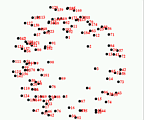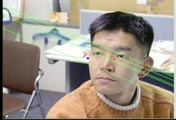Recovering Structure and Motion from Image Sequences
Recursive Factorization Method for the Paraperspective Model Based on the Perspective Projection
The factorization method, which allows us to reconstruct the motion of the camera and shape of the object simultaneously from multiple images, provides high stability in numerical computations and satisfactory results. To apply this method to real-time processing, the recursive factorization method has been proposed. However, factorization method based on the affine projection has a limitation in reconstruction accuracy, and to achieve accurate reconstruction, the motion should be restricted. To overcome this problem, we present a recursive factorization method for the paraperspective model based on the perspective projection. The present method is far superior to other ones, in that it not only achieves accurate Euclidean reconstruction in a short time but also provides high stability in numerical computations. Moreover, the method produces stable reconstruction in almost all cases even if some images contain errors because all images are treated as uniformly as possible.
A Robust Recursive Factorization Method for Recovering Structure and Motion from Live Video Frames
We present a fast and robust approach for recovering structure and motion from video frames. It first describes a robust recursive factorization method for affine projection. Using the Least Median of Squares (LMedS) criterion, the method estimates the dominant 3D affine motion and discards feature points regarded as outliers. The computational cost of the overall procedure is reduced by combining this robust-statistics-based method with a recursive factorization method that can at each frame provide the updated 3D structure of an object at a fixed computational cost by using the principal component analysis. We then demonstrate that the method can be used to estimate the dominant structure and the motion robustly and in real-time on an off-the-shelf PC..
References:
CVPR (Jun 2000), ICCV FRAME-RATE WORKSHOP (Sep 1999) , SPIE (Jul 1998)
CVPR (Jun 2000), ICCV FRAME-RATE WORKSHOP (Sep 1999) , SPIE (Jul 1998)
Affine Epipolar Geometry via Factorization Method
We present the intuitive interpretation of affine epipolar geometry for the orthographic, scaled orthographic, and paraperspective projection models in terms of the factorization method for the generalized affine projection (GAP) model proposed by Fujiki and Kurata (1997).
Using the GAP model introduced by Mundy and Zisserman (1992), each affine projection model can be resolved into the orthographic projection model by the introduction of virtual image planes, then the affine epipolar geometry can be simply obtained from the estimates of the factorization method.
Using the GAP model introduced by Mundy and Zisserman (1992), each affine projection model can be resolved into the orthographic projection model by the introduction of virtual image planes, then the affine epipolar geometry can be simply obtained from the estimates of the factorization method.
References
・ICPR (Aug 1998)
・ICPR (Aug 1998)
Feature Tracking on Occluding Boundaries for Modeling-by-videotaping
References:
・VSMM'96 (Sept 1996)
・VSMM'96 (Sept 1996)







